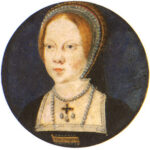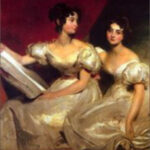During the lives of Robert and Elizabeth Barrett Browning, their poetry was considered to be the epitome of the day. Both were prolific writers even before their marriage. Robert Browning wrote hundreds of poems, dozens of plays and hundreds of letters to his wife and friends. Elizabeth Barrett Browning published over a dozen volumes of poetry and several essays.
The two wrote 574 letters to each other over a 20-month span of their courtship in England. They married in 1846, against the wishes of Elizabeth Browning’s father. They moved from England to Italy where they settled and lived until their deaths.
Elizabeth Browning lived from 1806 to 1861. Robert Browning was born in 1800 and died in 1889. The Academy of American Poets has biographies on both writers.
“My Last Duchess”
From the very first line of “My Last Duchess,” Robert Browning pulls readers in with his most famous didactic work. That’s my last duchess painted on the wall…” intones the narrator as he goes on for dozens of rhyming couplets. The poem works on several levels in that the rhymes fit into the tidy conversation.
Right from the beginning, the word “last” has many implications. Was she his most recent duchess in a long line? Was the woman his final try to have a marriage? Was the narrator planning on getting married again to someone more suitable, or would he make the same mistake again?
The work also serves as a warning. His many string of wives were unhappy with their man who imposed too strict of a lifestyle upon them. Even though the duke had riches aplenty, he had not love.
Consider these lines that serve as the theme of the poem.
“Her wits to yours, forsooth, and made excuse,
-E’en then would be some stooping; and I choose
Never to stoop. Oh sir, she smiled, no doubt,
Whene’er I passed her; but who passed without
Much the same smile? This grew; I gave commands;
Then all smiles stopped together. There she stands
As if alive. Will’t please you rise? We’ll meet
The company below, then. I repeat….”
In a traditional sense, the rhyme and meter are almost perfect as if imitating Shakespeare. As a contemporary poet, Browning would be shunned for being uncreative. For his day when the concentration was on the classics, he was considered a genius.
The entire work is found on SparkNotes.com.
“Sonnets from the Portuguese”
Elizabeth Barrett Browning’s most famous collection of poetry is “Sonnets from the Portuguese.” She was inspired by her love for Robert Browning and William Shakespeare to write this collection of 44 love poems in an Italian style with English rhymes. Elizabeth Barrett Browning had other famous works such as “Aurora Leigh,” but her “Sonnets” best sum up her life, love and poetry.
Sonnet number 43 is the most famous.
“How do I love thee? Let me count the ways.
I love thee to the depth and breadth and height
My soul can reach, when feeling out of sight
For the ends of Being and ideal Grace.
I love thee to the level of everyday’s
Most quiet need, by sun and candle-light.
I love thee freely, as men strive for Right;
I love thee purely, as they turn from Praise.
I love thee with a passion put to use
In my old griefs, and with my childhood’s faith.
I love thee with a love I seemed to lose
With my lost saints, — I love thee with the breath,
Smiles, tears, of all my life! — and, if God choose,
I shall but love thee better after death.”
The marriage can be summed up perfectly in Elizabeth’s most famous ode to her husband. The poem also serves as a 14-line journey through her life as she contemplates what it means to be someone’s soulmate as she grows older.
Her “Sonnets” can be found at the website of Amherst College.
In terms of writing and in love, the Brownings are my favorite writers because they were able to put their feelings to words most ardently and aptly.








